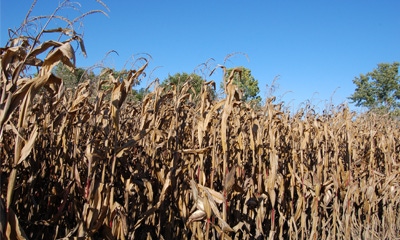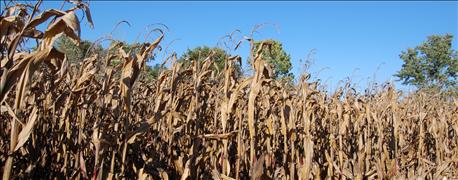July 25, 2016

If you had corn leaf diseases this season, you probably will have stalk rot, unless you aggressively controlled those leaf diseases with foliar fungicides. Leaf diseases make plants weak and predisposed to stalk rot.
Your job is to protect your crops from invaders and reduce losses. Knowing what’s out there may be helpful in prevention.
Here are six major stalk rot organisms that affect corn.
1. Anthracnose leaf blight and stalk rot are both caused by a fungus.

STRESS SETS UP STALK ROT: Various stresses could set plants up for stalk rot in the weeks ahead.
The fungus is Colletotrichum graminicola. It overwinters in corn debris. In the leaf blight phase, it produces long, wavy lesions on leaves. Depending on the weather during the grain-fill period, the pathogen can move to the stalks. This disease is easy to identify by the shiny black spots near the base of the plants, which eventually move up to several internodes. The fungus produces microscopic spores and gives the rind a black shine like shoe polish. Affected stalks start to decay inside and eventually lodge. Premature plant death interrupts grain fill and causes yield losses. Anthracnose stalk rot has become one of the most important corn diseases in the Corn Belt.
2. Diplodia stalk rot is caused by the fungus Diplodia maydis.
This organism also causes ear rot. Infections can occur within two weeks after silking. In the ear rot phase, it usually starts at the base, and eventually the whole ear may become rotted. When husks are peeled back, a white mold is visible between the kernel rows. The shank and husk of affected ears look bleached and whitish. The base of the stalk produces small black dots called pycnidia, which are embedded in the rind of the stalks and cannot be scraped off.
3. Fusarium stalk rot is caused by the fungus Fusarium moniliforme.
In the field, it’s difficult to distinguish between fusarium stalk rot and gibberella stalk rot, which is caused by the fungus Gibberella zeae. Both can infect ears as well as stalks. The pathogens overwinter in roots and stalks of a previous corn crop. Ears are infected at the tips first; then the infection moves toward the base. The pathogens attack the base of the stalks through the roots. When stalks are split open, tissues and fibers inside are deteriorated, soft and pink to reddish in color.
4. Charcoal rot is caused by the fungus Macrophomina phaseolina.
Charcoal rot infects plants near maturity. It begins as a root rot and moves into the lower internodes. Stalks display black fungal bodies known as sclerotia that look like charcoal dust. Stalks are killed, and lower internodes disintegrate.
5. Pythium stalk rot is caused by Pythium aphanidermatum and other Pythium species.
This disease occurs during hot and wet weather in summer. It usually infects a single internode near the soil line, which collapses. This disease is generally found in river-bottom fields with high humidity and poor drainage. Diseased stalk tissue appears water-soaked and brownish in color.
6. Bacterial stalk rot generally occurs following flooding.
The uppermost leaves wilt and die first under bacterial stalk rot. It causes tan to dark-brown, water-soaked, slimy pith tissue. Decay spreads rapidly downward, killing the plant and producing a foul odor. This disease favors high temperatures.
Nanda is president of Agronomic Crops Consultants LLC. Email him at [email protected], or call him at 317-910-9876.
You May Also Like




